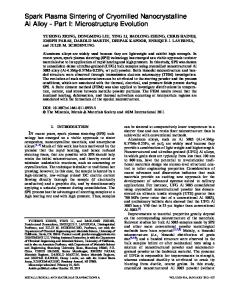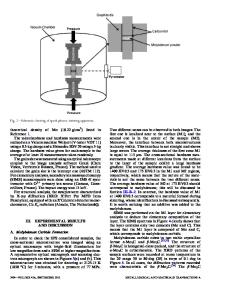Spark plasma sintering of gas atomized high-entropy alloy HfNbTaTiZr
- PDF / 694,762 Bytes
- 11 Pages / 584.957 x 782.986 pts Page_size
- 92 Downloads / 302 Views
ARTICLE Spark plasma sintering of gas atomized high-entropy alloy HfNbTaTiZr Frantisek Lukaca) Department of Materials Engineering, Institute of Plasma Physics CAS, 182 00 Praha 8, Czech Republic; and Faculty of Mathematics and Physics, Charles University, 180 00 Praha 8, Czech Republic
Martin Dudr, Radek Musalek, Jakub Klecka, Jakub Cinert, Jan Cizek, and Tomas Chraska Department of Materials Engineering, Institute of Plasma Physics CAS, 182 00 Praha 8, Czech Republic
Jakub Cizek, Oksana Melikhova, and Jan Kuriplach Faculty of Mathematics and Physics, Charles University, 180 00 Praha 8, Czech Republic
Jiri Zyka and Jaroslav Malek Research and development department, UJP PRAHA a.s., 156 10 Praha, Zbraslav, Czech Republic (Received 1 March 2018; accepted 14 August 2018)
A homogeneous HfNbTaTiZr high-entropy alloy was successfully processed via powder metallurgy route. For the initial powder feedstock material fabrication, the electrode inductionmelting gas atomization procedure was used, resulting in a spherical powder morphology and dual bcc phase composition distinguishable within the individual particles. Spark plasma sintering was then used for the powder compaction at sintering temperatures ranging from 800 to 1600 °C. By the characterization of the compact microstructures, lattice defects (microscopic porosity and vacancy-like misfit defects), and mechanical properties (hardness and three-point bending strength), the sintering conditions were optimized to obtain a fully dense, homogeneous, single-phase bcc material. It was found that such properties are achieved when sintering at 80 MPa pressure for 2 min at temperatures above 1200 °C, where the single bcc phase structure exhibited ductile behavior with considerable flexural strength and ductility at ambient temperature. Positron annihilation spectroscopy was used to characterize the evolution of atomic and mesoscale defects during optimization of the sintering process.
I. INTRODUCTION
The recently developed concept of multicomponent (or multiprincipal element) alloys1–3 provides an interesting combination of functional properties (such as thermal or mechanical) for practical applications.3 A promising subgroup of these novel multicomponent systems are the so-called high-entropy alloys (HEAs), where at least four respective elements are mixed in approximately even atomic content (alternative definition presents a value of at least 5% content for each element)4,5 while retaining a single-phase microstructure stabilized by the high configurational entropy of the mixture.6 At present, a vast amount of information is available for binary and selected ternary elemental systems. However, in the case of four, five (or even more) elements, very limited information can be found. The challenge here is the theoretical calculation of the elements’ mutual interaction (ab-initio, CALPHAD, etc.) in the mixture and it is not challenging to obtain relevant data, e.g., on the most interesting “eutectic” compositions. Also the attempts to describe the a)
Address all correspond
Data Loading...











